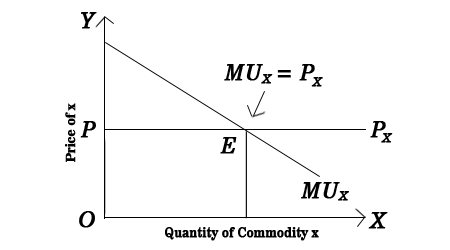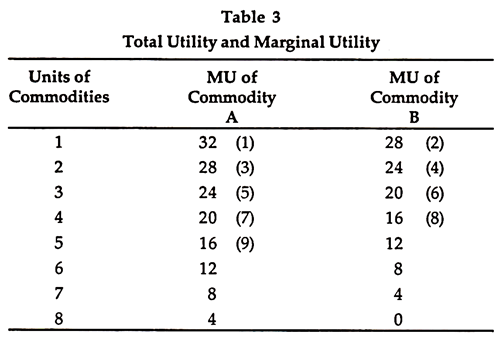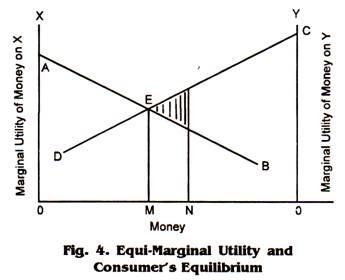In this post you will learn about the concept of consumer equilibrium concept and equilibrium in case of one commodity and two commodities.
CONSUMER EQUILIBRIUM
A consumer is said to be in equilibrium when he is buying such a combination of goods as leaves him with no tendency to rearrange his purchases of goods. Consumer equilibrium is the point of maximum satisfaction of the consumer.
He is then in a position of balance in regard to the allocation of his money expenditure among various goods.
ACCORING TO ANNA KOUTSOYIANNIS
“The consumer is in equilibrium when he maximizes his utility, given his income and the market prices.”
ASSUMPTIONS OF CONSUMER EQUILIBRIUM
The following assumptions are made to determine the consumer’s equilibrium position.
i. Rationality:
It is assumed that a consumer is rational and satisfies his/her wants in order of his/her preferences. Therefore, he/she firstly prefers to purchase those goods which yield highest utility and lastly those that provide lowest utility.
ii. Limited Money Income:
This refers to one of the important assumptions of the cardinal utility approach. According to this approach, a consumer has a limited amount of income to be expended on goods selected by him/her for consumption. Therefore, in such a case when there is an objective of utility maximization along with limited income, he/she selects those goods whose consumption is unavoidable.
iii. Maximization of Satisfaction:
This implies that every rational consumer strives to maximize his/her satisfaction from the limited income.
iv. Utility is Measurable:
It is assumed that utility is cardinally measureable. Therefore, utility of one unit of good equals to the units of money that a consumer is willing to pay, which means that 1 util = 1 unit of money.
v. Diminishing Marginal Utility:
It constitutes the basis for consumer behavior analysis. The utility gained falls as more and more units of a good are consumed.
vi. Constant Marginal Utility of Money:
It implies that whatever the level of income, the MU of money remains the same. According to this assumption, money is used as a measure of utility.
vii. Utility is Additive:
It Implies that utility is not only cardinally measurable, but can be added together to obtain the total utility. For instance, a consumer consumes X1, X2, and X3 units of good X and derives U1, U2 and U3 utils, respectively.
In such a case, the total utility derived by a consumer from n units of good X is expressed as:
Un = U1 (X1) + U2 (X2) + U3 (X3) +…………+ Un (Xn)
CONSUMER EQUILIBRIUM THROUGH CARDINAL UTILITY APPROACH
The utility approach was given by Marshall. As per Marshall, utility can be measured numerically like 1, 2, 3 in simple units called UTILS and expressed in total and marginal utility. This is called CARDINAL MEASURE OF UTILITY.
A consumer may attain equilibrium in case of consumption of a single commodity as well as when he is consuming two commodities available at same and different prices. The different cases to be considered under the utility approach are described below.
CONSUMER EQUILIBRIUM IN CASE OF SINGLE COMMODITY
Consumer’s Equilibrium in case of one commodity can be well explained by the use of law of diminishing marginal utility. The Law of Diminishing Marginal Utility states that the amount of satisfaction provided by the consumption of every additional unit of a good decrease as we increase the consumption of that good. Marginal Utility is the change in the utility derived from the consumption of an additional unit of a good.
CONDITION OF EQUILIBRIUM
In case of single commodity, the consumer is in equilibrium if the marginal utility derived from the commodity is equal to the price paid for that commodity.
MU= PRICE
TABULAR EXPLANATION: The consumer equilibrium in case of single commodity can be explained as follows:
| UNITS OF COMMODITY | PRICE | MARGINAL UTILITY |
| 1 | 10 | 14 |
| 2 | 10 | 12 |
| 3 | 10 | 10 |
| 4 | 10 | 8 |
| 5 | 10 | 6 |
The table shows the price of commodity Rupees 10 which is constant. The units of commodities are 5. The consumer attains his equilibrium by consuming3 units of the commodity. As by consuming 3 units of commodity the price is equals to the marginal utility i.e. 10.
DIAGRAMATIC PRESENTATION
The consumer equilibrium in case of single commodity can be explained with the help of following diagram:

The quantity of the commodity is shown as OX axis. The price of the commodity is shown at OY axis. At point E there is equilibrium as there is price equals to the marginal utility of the product.
CONSUMER EQUILIBRIUM IN CASE OF TWO COMMODITIES
The consumer’s equilibrium in case of two commodities can be explained with the help of law of equi-marginal utility. This law states that a consumer should spend his limited income on different commodities in such a way that the last rupee spent on each commodity yield him equal marginal utility in order to get maximum satisfaction.
CONDITION OF THE EQUILIBRIUM

The consumer attains the equilibrium where marginal utilities of both commodities are equal to marginal utility of money.
If MUx/Px > MUy/Py : It means utility per rupee from consumption of good x is greater than utility per rupee from consumption of good y.
The consumer should increase the consumption of good x and reduce the consumption of good y. By doing so the utility per rupee from good x will decrease and utility per rupee from good y will increase and ultimately both become equal. The consumer will attain equilibrium.
If MUx/Px < MUy/Py: It means utility per rupee from consumption of good x is less than utility per rupee from consumption of good y.
The consumer should increase the consumption of good y and reduce the consumption of good x. By doing so the utility per rupee from good y will decrease and utility per rupee from good x will increase and ultimately both become equal. The consumer will attain equilibrium.
Hence in case of two commodities the consumer attains equilibrium when
MUx/Px = MUy/Py = MUm
EXPLANATION
The consumer equilibrium in case of two commodities can be explained as follows:

The table reveals that the consumer has Rs. 9 which he can spend on the different commodities, namely, A and B. We also assume that the each unit of a commodity has the price of Re. 1. The various units of two commodities have been shown which gives him different marginal utilities. The MU of A and B are decreasing. He can maximise his satisfaction when he spends Rs. 5 on commodity A and Rs. 4 on commodity B.
His total utility is 32+28+24+20+16 of A and 28+24+20+16 of B which is 208 units. He cannot attain more utility by spending his given income in different way.
DIAGRAMMATIC PRESENTATION

The diagram shows that consumer attains his equilibrium at point E where marginal utility of commodity X is equal to the marginal utility of commodity Y.
